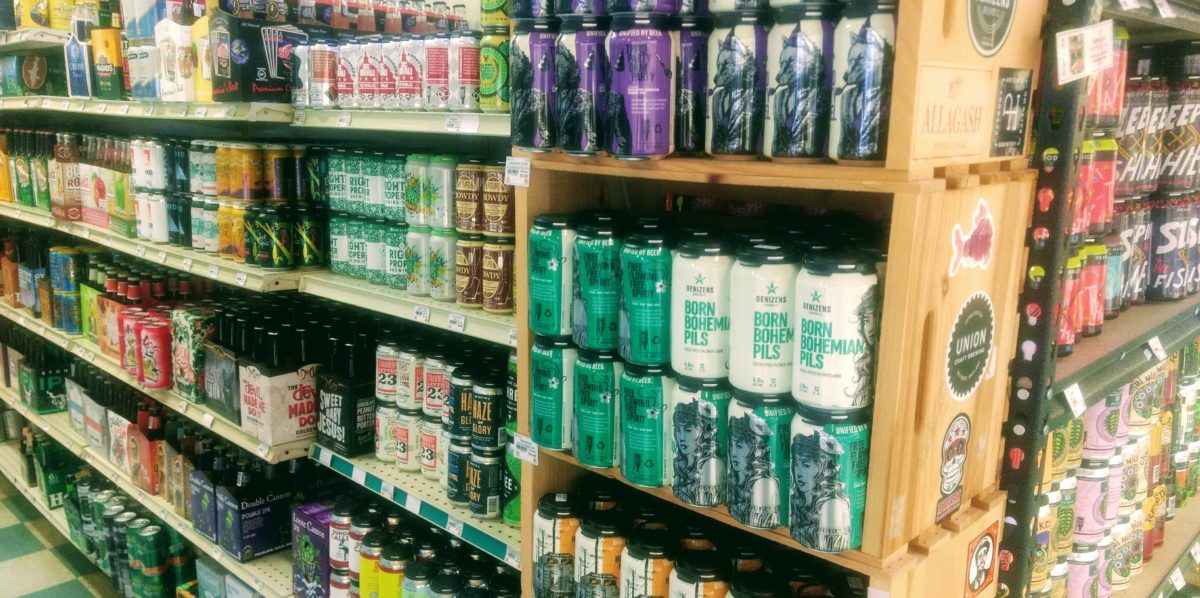Leandra Nichola, (soon-to-be-former) Beer & Wine Manager
Today, the beer department looks a lot different than it did a year ago. And, there are a few reasons for that: the addition of a beer and wine manager to the store, increased access to local breweries who are self-distributing, and the general explosion of craft beer across the country and in the D.C. area. But, visually, one of the biggest changes has been going from an almost all-bottle department to a two-thirds-can department. In the beer world, we couldn’t be happier. But, I know from the many questions I get from member-owners and shoppers, that it’s not totally clear why the shift is happening (or why we should all be happy about it). So, here’s the scoop.
Cans are lighter on our carbon footprint
Because cans are lighter than glass, we can fit more cans on trucks – both when coming to the store and when they head to a recycling center. This means fewer trips and less gas burned. Practically speaking, it also means you can fit more in your recycle bin because those cans can be squashed down into itty-bitty little things. Cans also come with less packaging. Those paper bottle carriers and aluminum tops head right to the recycle bin with little chance of being reused. The heavy-duty plastic holders for cans, however, can be reused numerous times before being tossed in the recycle bin. We reuse them in the store for our mix packs and we have just started to collect them to be reused at local breweries. (So, stash them and bring yours the next time you’re in the store!)
Cans give us more space
As our regular shoppers know, the Co-op is bursting at the seams with all kinds of natural food goodness. The beer department is no different. For every 6-pack of bottles, we can fit two 6-packs of cans. This means both more options on the shelf, as well as a more well-stocked department since our tiny beer closet can be piled high with cans.
Cans are friendlier to new breweries
Canning beer takes up less space than bottling, making it attractive to new breweries. Also, while there was a time when folks had to order large amounts of printed cans in order to get going, many breweries are choosing plain cans and printed labels to speed up their entry into the canned beer market. And, lower transportation costs make cans a more accessible choice for new breweries. Plus, if you haven’t heard, some breweries collaborate to share the costs of brewing and delivering their product, including when it comes to canning.
Canned beer tastes better
Cans are essentially mini-kegs. They allow no light or air to enter (unlike bottles that allow a bit of both), perfectly preserving your favorite brew for longer than bottles. You also may be less likely to drink your beer out of a can – and, pouring into a glass ensures you get the full beer-indulging experience. Drinking from a bottle or a can cuts off almost all your access to a beer’s aroma and color, major contributors to how we experience taste. So, cans might actually help you enjoy your beer more.
Cans can go almost anywhere
Heading to the pool, camping, or your neighbor’s place, cans make bringing beers along easier (and safer!). They also have the perk of cooling down faster than bottles, so you can throw them on ice and enjoy cold beer (or cider or wine) minutes later. And, you can open them anywhere, whether you have a bottle opener or not – say farewell to the days of trying to make a lever out of your counter, scissors, belt buckle, lighter or, well, just about anything.
Next time you’re in the store, take a moment to notice all the cans in Aisle 6. Smile with gratitude. Then, grab a sixer and enjoy!

